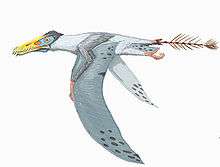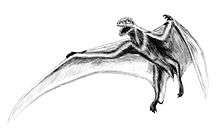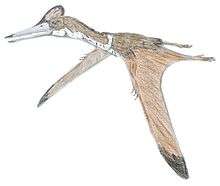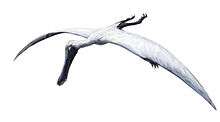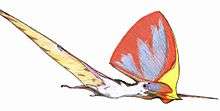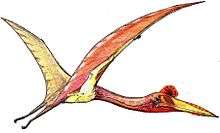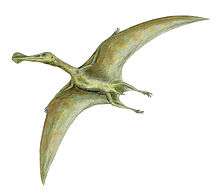Boreopteridae
Boreopteridae (meaning "northern wings") is a group of ornithocheiromorph pterosaurs from the Aptian-age Lower Cretaceous Yixian Formation of Liaoning, China.[1]
| Boreopterids | |
|---|---|
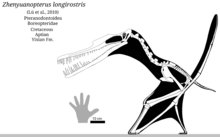 | |
| Skeletal diagram of Zhenyuanopterus | |
| Scientific classification | |
| Kingdom: | Animalia |
| Phylum: | Chordata |
| Order: | †Pterosauria |
| Suborder: | †Pterodactyloidea |
| Clade: | †Pteranodontoidea |
| Clade: | †Ornithocheiromorpha |
| Clade: | †Lanceodontia |
| Family: | †Boreopteridae Lü et al., 2006 |
| Type species | |
| †Boreopterus cuiae Lü & Ji, 2005 | |
| Genera | |
Classification
In 2006, Lü Junchang and colleagues named the clade Boreopteridae for the clade containing the common ancestor of Boreopterus and Feilongus and all its descendants, which the authors reclassified as close relatives of the ornithocherids. (Feilongus had originally been considered a gallodactylid). Many possible boreopterids were subsequently described,[2] one possible example being Aetodactylus, which has been claimed to be similar to Boreopterus.[3] Originally considered close relatives of the ornithocheirids, many of these supposed boreopterids have been found to belong to other groups of the pterodactyloid lineage. Boreopterus and Feilongus were found by Andres and colleagues in 2013 to be closely related to Cycnorhamphus, making them members of the Gallodactylidae as had been originally thought when Feilongus was discovered.[4] A subsequent analysis including the other supposed boreopterids found that Boreopterus itself, and therefore the name Boreopteridae, was indeed a member of the ornithocheiroid clade, but that Feilongus was in fact a ctenochasmatoid closely related to Gnathosaurus.[5] The true boreopterid clade was found to contain Boreopterus, Guidraco, and Zhenyuanopterus by Andres and colleagues in 2014,[5] and was then found to contain just Boreopterus and Zhenyuanopterus by Wu and colleagues in 2017.[6]
Phylogeny
The cladogram below is a topology recovered by Pêgas et al. (2019). In the analyses, they found Boreopteridae to group with the more derived Ornithocheirae.[7]
| Lanceodontia |
| |||||||||||||||||||||||||||||||||||||||||||||||||||||||||||||||||||||
Palaeoecology
The known taxa come from the Yixian Formation of Liaoning, which represented a lake system, suggesting that these animals occurred in freshwater habitats. They are thought to have foraged while swimming, trapping prey with their needle-like teeth;[2] this method of fishing was probably analogous to that of Platanista dolphins, which share a similar dentition.
References
- Junchang, Lü; Ji, S.; Yuan, C.; Ji, Q. (2006). Pterosaurs from China (in Chinese). Beijing: Geological Publishing House. p. 147 p.
- Mark Witton, 2011
- Myers, Timothy S. (2010). "A new ornithocheirid pterosaur from the Upper Cretaceous (Cenomanian–Turonian) Eagle Ford Group of Texas" (pdf). Journal of Vertebrate Paleontology. 30 (1): 280–287. doi:10.1080/02724630903413099.
- Andres, B.; Myers, T. S. (2013). "Lone Star Pterosaurs". Earth and Environmental Science Transactions of the Royal Society of Edinburgh. 103: 1. doi:10.1017/S1755691013000303.
- Andres, B.; Clark, J.; Xu, X. (2014). "The Earliest Pterodactyloid and the Origin of the Group". Current Biology. 24: 1011–6. doi:10.1016/j.cub.2014.03.030. PMID 24768054.
- Wu, W.-H.; Zhou, C.-F.; Andres, B. (2017). "The toothless pterosaur Jidapterus edentus (Pterodactyloidea: Azhdarchoidea) from the Early Cretaceous Jehol Biota and its paleoecological implications". PLoS ONE. 12 (9): e0185486. doi:10.1371/journal.pone.0185486. PMC 5614613. PMID 28950013.
- Rodrigo V. Pêgas, Borja Holgado & Maria Eduarda C. Leal (2019) On Targaryendraco wiedenrothi gen. nov. (Pterodactyloidea, Pteranodontoidea, Lanceodontia) and recognition of a new cosmopolitan lineage of Cretaceous toothed pterodactyloids, Historical Biology, doi:10.1080/08912963.2019.1690482

